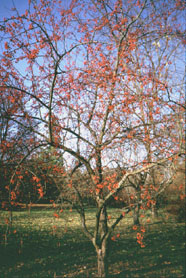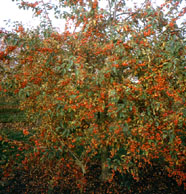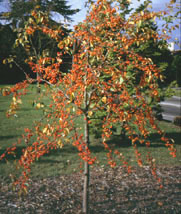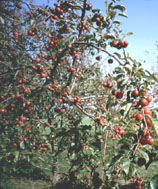| Crabapples are small apples. The line between a small regular apple such as is grown in an orchard, and a large crabapple --is blurry. An arbitrary size often cited is 2 inches. If the fruit is smaller it is a crabapple, if larger an apple. This rule-of-thumb is clumsy because many trees bear fruit that averages about 2 inches. In such cases people need also look at tree form, foliage and flowers. Doing so enables an accurate classification of most trees as small-fruited domestic apples or as large-fruited crabapples. |
The role of crabapples in our orchards, parks, gardens and landscapes varies. Certain kinds are valued variously for:
|
| Floral beauty |
| Floral fragrance |
| Floral pollination |
| Fruit display |
| Fruit worth harvesting |
Fruit to attract birds
|
| Crabapple tree shape varies from narrowly erect to oval, round, mushroom shaped or weeping. Size ranges from dwarf "toy trees" to specimens as large as any regular apple tree. Leaves can be green or purplish-red. Flowers may be tiny and white, or as large as 2.5 inches wide, and can be pink or red, with 5 petals or many more. In brief, the crabapple clan is diverse. |
| Though they are often called flowering crabapples, I prefer the term ornamental crabapples. And since the flower display of any given kind lasts only from one or two (rarely three) weeks per year, I think more of us should plant crabapples that bear long-lasting attractive fruit. The fruit can be showy for at least a month and in some cases up to 5 months. |
| Within the city limits of Seattle there are, I estimate, about 150 different kinds of crabapples. I can cite locations of at least 100 kinds in various parks and private gardens, as well as at schools, hospitals, cemeteries and so on. Another 32 kinds are known to me only at Washington Park Arboretum. And others exist in Seattle that I have not yet found and/or identified. |
| My choice of the following 20 kinds notable for fruit display, and the remarks I make about them, pertain to how these trees do in Seattle. East of the Cascade mountains most crabapple trees perform better; they are less scabby and more fruitful. I am singling out 20 kinds whose fruit lasts reasonably well into late fall or winter. Many others have fruit that is glorious in late summer and early fall, but then drops (examples: Dolgo, Hopa, Klehm's Improved Bechtel). Also I am citing clones/cultivars only, fully cognizant that certain Malus prunifolia or Malus robusta (that is Malus baccata x Malus prunifolia) individuals have fruit showy enough to be listed. The glitch is: such trees cannot be found in commerce. As it is, certain trees I list below are darn hard to find for sale currently. |
Eventually I hope to get photographs of all of these, so you can see them in living color. Meanwhile, I can only counsel patience.
Back |

Nov. 22 Malus Donald Wyman photo by ALJ
|

Nov. 8 Malus Evereste photo by ALJ |

Oct. 17 Malus Golden Hornet photo by ALJ |

Nov. 1 Malus Professor Sprenger photo by ALJ |

Oct. 6 Malus Ralph Shay photo by ALJ |

March 3 Malus Red Jewel photo by ALJ |

